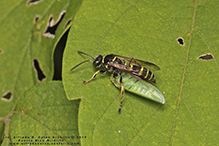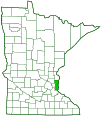sand wasp
(Argogorytes nigrifrons)
Conservation • Description • Habitat • Ecology • Distribution • Taxonomy
Conservation Status |
|
|||||||
| IUCN Red List | not listed |
|||||||
| NatureServe | not listed |
|||||||
| Minnesota | not listed |
|||||||
Description |
||
Argogorytes is a widespread genus of sand wasps in the subtribe Bembicini. There are 31 Argogorytes species worldwide. Only two species occur in North America, and only one of these occurs in Minnesota. The appearance (morphology) and behavior (biology) of most species in the tribe Bembicini, all species except those in the well-studied genus Bembix, are woefully understudied. The morphology is given in large part in terms of the absence of features that define other closely related tribes. Biological information is now available for five Argogorytes species, but even for these there is little evidence on nest structure and prey. No biological information is known for the two North American Argogorytes species. Argogorytes nigrifrons is a medium-sized sand wasp. It occurs in the United States and southern Canada east of the Great Plains. The body is black with yellow markings. It is similar in appearance to a potter or mason wasp. There are two large compound eyes on the sides of the head and three simple eyes (ocelli) in a triangle on top of the head (vertex). The inner margins of the compound eyes are nearly parallel. The ocelli are not depressed below the surrounding surface of the vertex. The middle ocellus lens is present and more or less rounded. The jaws (mandibles) are not notched on the underside. On the upper side of the thorax, the large middle plate (scutum) does not have a complete V shaped line (notalus). The oblique ridge (carina) on each side toward the rear is absent. On the underside of the rear part of the body (metasoma), the first plate (sternite) has a single carina at the base. On the male the metasoma has six visible segments, and there is no prong at the tip. The last part of each leg (tarsus), corresponding to the foot, has a pair of claws at the tip. The claws are simple, not split. On the female, the fourth leg segment (tibia) has two spurs at the tip. On the forewing, the dark cell on the leading edge (stigma) is moderately large. The marginal cell is not bent away from the wing margin. There are three submarginal cells. The second submarginal cell is not petiolate. |
||
Size |
||
|
||
Similar Species |
||
Habitat |
||
|
||
Ecology |
||
Season |
||
|
||
Behavior |
||
|
||
Life Cycle |
||
Nests are created in the ground in sandy habitats. |
||
Larva Food |
||
|
||
Adult Food |
||
|
||
Distribution |
||||
|
Sources |
|||
| 3/30/2023 | ||||
Occurrence |
||||
|
||||
Taxonomy |
|||
Order |
Hymenoptera (ants, bees, wasps, and sawflies) | ||
Suborder |
Apocrita (narrow-waisted wasps, ants, and bees) | ||
Infraorder |
Aculeata (ants, bees, and stinging wasps) | ||
Superfamily |
Apoidea (bees and apoid wasps) | ||
Family |
Crabronidae (square-headed wasps, sand wasps, and allies) | ||
Subfamily |
Bembicinae | ||
Tribe |
Bembicini (sand wasps) | ||
| Subtribe | Exeirina | ||
Genus |
Argogorytes | ||
| Subgenus | Archarpactus | ||
Subfamily Subtribe |
|||
Synonyms |
|||
Arpactus nigrifrons Gorytes bollii Gorytes neglectus Gorytes nigrifrons |
|||
Common Names |
|||
There is no common name for this species. The common name of the tribe Bembicini is sand wasps, and it is used here for convenience. |
|||
Glossary
Carina
An elevated keel or ridge.
Labrum
The upper part of the mouth, sometimes considered the lower part of the face, corresponding to the upper lip, on an insect or crustacean.
Metasoma
In Hymenoptera: the armored rear part of the body, consisting of the second segment of the abdomen and all segments posterior to it.
Ocellus
Simple eye; an eye with a single lens. Plural: ocelli.
Scutum
The forward (anterior) portion of the middle segment of the thorax (mesonotum) in insects and some arachnids.
Stigma
In plants, the portion of the female part of the flower that is receptive to pollen. In Lepidoptera, an area of specialized scent scales on the forewing of some skippers, hairstreaks, and moths. In other insects, a thickened, dark, or opaque cell on the leading edge of the wing.
Tarsus
On insects, the last two to five subdivisions of the leg, attached to the tibia; the foot. On spiders, the last segment of the leg. Plural: tarsi.
Tibia
The fourth segment of an insect leg, after the femur and before the tarsus (foot). The fifth segment of a spider leg or palp. Plural: tibiae.
Vertex
The upper surface of an insect’s head.
Visitor Photos |
|||||
Share your photo of this insect. |
|||||
| This button not working for you? Simply email us at info@MinnesotaSeasons.com. Attach one or more photos and, if you like, a caption. |
|||||
Alfredo Colon |
|||||
 |
|||||
MinnesotaSeasons.com Photos |
|||||
|
|||||

Slideshows |
||

Visitor Videos |
|||
Share your video of this insect. |
|||
| This button not working for you? Simply email us at info@MinnesotaSeasons.com. Attach a video, a YouTube link, or a cloud storage link. |
|||
Other Videos |
|||

Created: 3/30/2023
Last Updated:


